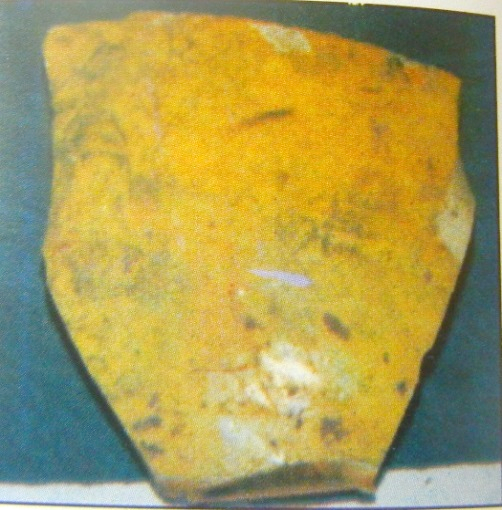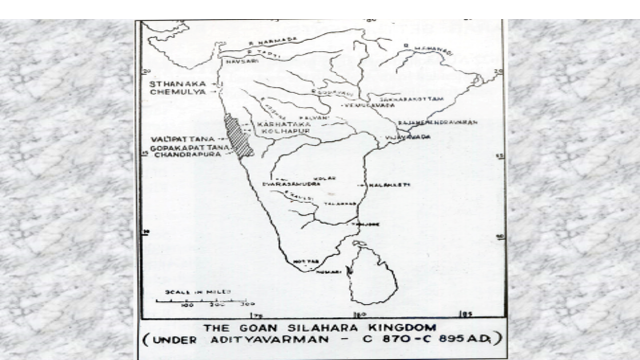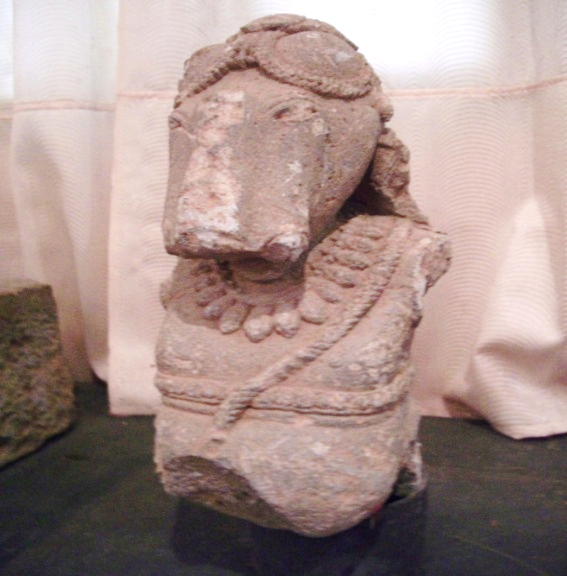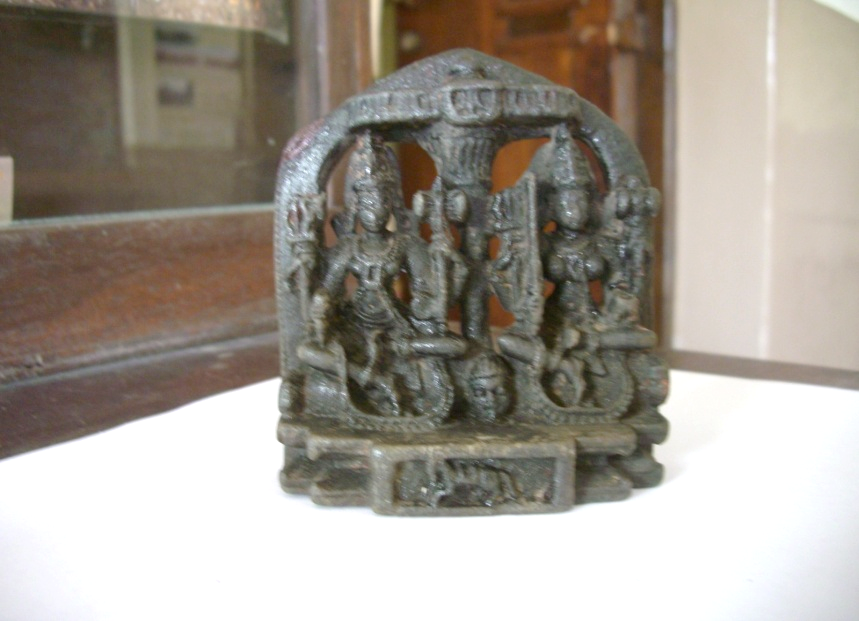From the main Kadambas and others, Goa passed into the hands of the Chalukyas of Badami who ruled South India from about the year 566 AD to about 756 AD. By 756, the Chalukyas of Badami were defeated by the Rashtrakuttas1. Each of the two dynasties had their feudatories as their governors in Goa.
- SENDREKAS
A certain Ventuvallabha of Sendreka family from Sindh, obtained some grants of land in Satari taluka of Goa from a Chalukya ruler, Pulakesi II whose rule lasted from 610 to 640 AD. Fixing his capital at Ponda, Ventuvallabha de-silted and fortified the Gopakapattana port, according to a copper plate inscription found in Chiplum.2 Hence in honour of the Sindh family, the Gopakapattana port was also called Sindapura3 currrupted to Sindabur,4 Sindabor or Cintabor5, further abbreviated to Sibor or Cibor6 by the different merchants who traded with it. It was frequented by the Arab merchants and travellers from the 8th century AD7.
- SANCAI POTTERY

A piece of yellow pottery deciphered by veteran ASI Archaeologist as being from China, belonging to the 7th century, was found in the Pilar tank. Any ship bringing Chinese wares could have touched the port of Goa (Sindapura/ Gopakapattaana) after it was de-silted by Ventuvallabha Sendreka.
- SHILAHARAS
The rulng Chalukya Emperor of Badami, Kirtivarma II, was sovereign of the entire Konkan coast but was defeated by Dantidurga, the founder of the Rashtrakutta dynasty in 756 AD. The Rashtrakuttas are said to have originated from Loutolim according to some authors but settled in Maharashtra, their capital being Malkhed.8 The Rashtrakuttas are said to have patronized art and architecture that led to the masterpieces of Ellora caves. Rashtrakutta ruler Krishna II, son of Dantidurga, annexed the South Konkan region and placed Sanaphulla of the Shilahara family as his feudatory over it9. In course of time, three Shilahara families are supposed to have held sway over the entire Konkan, with capitals at Thana (Northern Shilaharas), Kholapur (Maratha Shilaharas) and Govapuri (South Konkan Shilaharas), independently of each other. They were feudatories of the Rashtrakuttas, though with a good amount of autonomy in the territories subject to them.
A copper plate grant of Kharepattan speaks about Sanaphulla, as the founder of the South Konkan Shilahara dynasty and his successors, who ruled from 765 AD. This grant was issued by Rattaraja (995-1020). Seeing that there was a good port frequented by foreign ships, Sanaphulla built a good city, around the present Pilar hillock, and made it his capital as a feudatory (or governor) of the Rashtrakuttas in the South Konkan Region.
Govapuri was perhaps also known, at that time, as Simhala, for these South Konkan Shilaharas have been described as ‘the best of Simhala kings’. It is stated that this reference indicates some real or fanciful connection with Simhala or the island of Ceylon. At a later period too, when the island of Goa was captured by the Kadambas of Goa, ruling from Chandrapura (present day Chandor – Goa), the Demgave inscription describes it as the conquest of Simhala (supposed to be today’s Sri Lanka/ Ceylon) as we shall see later10
We know about the Goan Shilahara or the South Konkan Shilahara dynasty mainly through the Kharepattan copper plate of Rattaraja which we have referred to above. The plate was issued in 1008 AD and we have ten known rulers of the dynasty whose rule lasted from 765 AD to about 1020 AD. The exact regnal period of each ruler not being available, Prof. A. S. Altekar has given 25 regnal years to each, as follows:

- Sanaphullla (765-795)
- Dammayira (795-620
- Aiyaparaja (820-845)
- Avasara I (845-870)
- Adsityavarma (870-895)
- Avasara II (895-920)
- Indraraja (920-945)
- Bhima (945-970)
- Avasara III (970-995)
- Rattaraja (995-1020)
Side by side with the names, the Map of South India, in figure 11(a) shows the extent of the Goa Shilahara kingdom at its zenith. The above mentioned Kharapattan copper plate grant of Rattaraja further says that Aiyaparaja (820-845) invaded Chandrapura and is said to have bathed with coconut water to celebrate his victory over the kingdom. Avasara II (895-920) helped the rulers of Chandrapura. Bhima (945-970) marched against the ruler of Chandapura, who had attempted to do away with the Shilahara over-lordship and seized Chandramandala including Chandrapura around 970 AD, just as Rahueclipses the moon at the lunar eclipse. The Chicodi plate of Avasara III gives the date corresponding to 18th October, 988 AD11
- END OF SHILAHARA RULE
In the 11th century, the Western Chalukyas of Kalyani defeated the Rashtrakuttas. At this moment, Rataraja the ruler of Govapuri tried to assert his independence, but was defeated by the Chalukya emperor Jayasimha. In this situation, the Northern Shilahara ruler Arikesarin of Thana, invaded the entire Konkan as far as Gopakapattana, but was soon killed by the Maratha Shilahara ruler Gonka of Kholapur when the latter attacked Thana, the capital of Arikesarin. In this confused situation, while Chittaraja, the nephew of Arikesarin was succeeding him at Thana, the Goa Kadamba ruler Shasthadeva II attacked and conquered Govapuri and the entire Konkan region up to Thana. That was the end of the Shilahara dynasty of Goa.
- ARCHAEOLOGICAL FINDS

This historical data is again confirmed by the archaeological finds at Pilar. An exquisitely carved out idol of Ganesha on black granite stone, belonging to the 8th century AD, (when the Shlaharas were ruling over Goa as the feudatories of the Rashtrakuttas), was found in a well just outside the Pilar compound (fig. 9b). Though mutilated, it has unique features, such as: head dress with a lotus, a necklace and the Brahmin’s thread on its shoulder. According to Dr A. Sundara, veteran archaeologist of the ASI, who visited the Pilar Museum several times, this idol is comparable to Dvibhuja Ganesha of Grishneshwara, near Ellora Caves, as well as the falling Rameshwara Ganesha near Brahmagiri in Chitradurga district in Karnataka; it is also similar to the existing idol in the Bandora temple in Ponda, Goa, which however is fully intact and is also dated more or less to the same period.
- ARAB SETTLEMENTS

In 622 AD Mohammad, the prophet, founded Islam in Arabia. The Arab sphere of influence extended from Arabia to the east and west. By 711 AD they conquered Sindh and took over the Indian Ocean trade from the Sasanid dynasty, mentioned in the previous Chapter.
Slowly the Arabs settled along the West Coast of India up to Kerala and beyond and their settlements came to be called Hanjuman Nagaras12 There was one such settlement in Chimbel and later on, one of the richest Taji merchants named Modamod had a ship-building and repairing station at the Chimbel- Ribandar water front, as we shall see in the next Chapter.
The Pilar Seminary Museum has some bits of pottery of this period when trade may have flourished between the Shilaharas and the Arabs through the Arabian Sea. The pottery pieces have been scientifically dated as belonging to around the period of the 8th century. This pottery could have been imported through the Gopakapattana port and was found in the Pilar tank at a depth of about 5 metres (figure 12) by the students of the Seminary during their annual cleaning routine of the tank in the nineteen-nineties.
- SHILAHARA – KADAMBA WAR HERO

The discovery in the Pilar tank, of a small but delicately carved hero stone of a warrior, who apparently died in the Shilahara Kadamba war, seems to confirm the findings of the historian, A.S. Altekar, in this regard13. It is a beautiful specimen of sculpture showing the warrior’s head between a sitting Shiva and Parvati at their feet, his 2 wives and horse, below. All of them are supposed to have attained Moksha. The sculpture might have been worshipped by the family of the descendants of the hero.
1 Dr. P. B. Dessai, op it. pp. 93-94, 109, 114-115
2 V. T. Gune, Gazettier of the Union Territory of Goa, Daman & Diu, Vol. I, Panjim, 1979, pp 72-82
3 A. R. S. Dhume, Cultural History of Goa from 10,000 BC to 1352 AD, Panjim. MAPP Printers, 1985, p 220
4 Ranabir Chakravarti, Chandrapura / Sindabur and Gopakapattana: two ports on the West Coast of India, in Proceedings of the Indian History Congress, Aligarh, 2000, pp 151-161.
5 J. N. da Fonseca, An Historical and Archaeological Sketch of the city of Goa, Asian Educational Services, New Delhi, (Reprint of 1986), p 119
6 Dr Pius Malekandathil, St Thomas Christians and the Indian Ocean, paper presented at a Symposium held at St Ephrem’s Theological College, Satna on 29-3-2001.
7 A. R. S. Dhume, Cultural History… op cit. pp223-224
8 Prajal Sakardande,”Rashtrakuttas Lords of Loutolim”, Panorama Navhind Times, 29-10-2000.
9 Prof. A. S. Altekar, The Shilaharas of Western India, Indian Culture Vol. II pp. 399-400
10 G. A. Pereira, op cit. Pp. 28-30, 36-38
11 A. S. Altekar, The Shilaharas of Western India, op cit. pp399-400
12 Nandakumar Kamat, Gopakapattan through the Ages pp 254-266
13 A.S. Altekar, Shilaharas of Western India, Indian Culture, Vol. II, Calcutta,1935, pp 399-400
